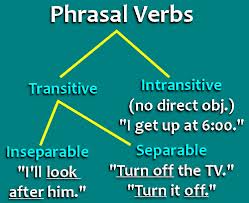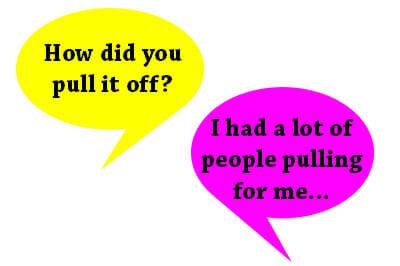Top Espresso English phrasal verbs tips:
ALL Espresso English phrasal verbs tips
Phrasal Verbs in Conversation Course
Table of contents:
What are Phrasal Verbs?
They are verbs with two or three words: main verb + particle (preposition or adverb). They are very common in the English language!
Phrasal verb examples:
- I wake up at 7:30 every day.
- Please turn off the TV.
- My brother and I don’t get along. We fight all the time.
- She came up with a good idea.
Phrasal verbs are difficult because you often can’t understand the meaning of each expression from the words themselves. Also, many common phrasal verbs are very similar (take up, take on, take in, take over, etc.) and a number of them have multiple meanings.
Native English speakers use phrasal verbs very often in spoken English! We can use them in written English, too – in more informal writing. With more formal writing, we would use more formal verbs instead.
In this lesson, you’re going to learn 4 types of phrasal verbs and how each one functions in an English sentence.
If you’d like to learn more than 500 phrasal verbs in a natural way, by studying how they are used in conversations, come join my Phrasal Verbs in Conversation Course!
Phrasal verbs can be transitive or intransitive.
Transitive phrasal verbs can be separable or inseparable.

Phrasal verbs in English are transitive or intransitive. The transitive phrasal verbs can be separable or inseparable, but the Intransitive phrasal verbs cannot be separated.
Intransitive Phrasal Verbs
Intransitive phrasal verbs have no direct object. (Something that is “acted upon” by the verb).
Examples:
- I woke up at 10:30 AM.
- You can come over to my house after school.
- He’s going back to Russia next month.
Click here for a list of 15 intransitive phrasal verbs with example sentences.
More intransitive phrasal verbs + meanings
Transitive Phrasal Verbs
Transitive phrasal verbs have a direct object.
Examples (direct object is in blue):
- You need to fill out this form to register for the course.
(fill out = complete)- I’m going to cut down on fast food this year.
(cut down on = reduce)- Check out that website – it’s really great!
(check out = look at, go to)
Separable & Inseparable Phrasal Verbs
Transitive phrasal verbs can be separable or inseparable.
If it is separable, it means you can separate the two words and put the direct object in the middle.
If it is inseparable, then you can’t do this.
Separable Phrasal Verb Example: TURN OFF
- Please turn off the TV.
- Please turn the TV off.
Click here for a list of 15 separable phrasal verbs with example sentences.
Inseparable Phrasal Verb Example: LOOK AFTER (= monitor, take care of)
- I’ll look after your dog while you’re on vacation.
- I’ll look your dog after while you’re on vacation – INCORRECT
Click here for a list of 15 inseparable phrasal verbs with example sentences.
More inseparable phrasal verbs
Word Order for Separable Phrasal Verbs
When the direct object is the specific name of a thing or person, it can be located after the phrasal verb or in the middle:
- I threw away the old pizza.
- = I threw the old pizza away.
However, when the direct object is a pronoun (me, you, him, her, us, them, it), then it MUST go in the middle:
- I threw it away.
- I threw away it. – INCORRECT
Here’s an example with a person:
- They’ll pick up John from the airport.
- = They’ll pick John up from the airport.
- = They’ll pick him up from the airport.
- They’ll pick up him from the airport. – INCORRECT
Review
We’ve learned about:
- Intransitive phrasal verbs, which have no direct object, like wake up: I woke up at 6:00.
- Transitive phrasal verbs, which do have a direct object: I took off my hat.
- Separable phrasal verbs, which can have the direct object or the pronoun in the middle: I took my hat off / I took it off. If we use a pronoun like me, you, him, her, us, them, or it, then it MUST go in the middle and not at the end.
- Inseparable phrasal verbs, which must have the direct object at the end, and not in the middle: They’re looking after our children.
How do you know if a phrasal verb is transitive or intransitive, and separable or inseparable?
Unfortunately, there’s no “rule” for looking at a phrasal verb and knowing what type it is! The best way is just to study each phrasal verb in context with lots of examples.
And that’s what we do inside my Phrasal Verbs in Conversation Course, which will teach you 500 phrasal verbs in a fun, fast, and effective way!
Challenge: Learn 50 phrasal verbs in 5 days
Here’s a fun challenge: learn 50 phrasal verbs in 5 days with fun, quiz-based lessons!
Watch each video below, then download the accompanying worksheet to review and practice.

Day 1 – Download the worksheet to review & practice

Day 2 – Download the worksheet to review & practice

Day 3 – Download the worksheet to review & practice

Day 4 – Download the worksheet to review & practice

Day 5 – Download the worksheet to review & practice
Free Download: Learn 100+ phrasal verbs fast!
Download these phrasal verb “fireworks” to learn and practice 100+ common English phrasal verbs!
Right-click on the image and select “Save” or “Save as…”
Phrasal Verbs in Conversation Course
Take in, take out, take off, take away, take over, and take back: These are examples of phrasal verbs… and they ALL have different meanings!
This can be really frustrating because using the wrong phrasal verb can change the whole sentence.
And what’s worse is that each phrasal verb can have multiple definitions.
For example, TAKE OFF can mean:
- When an airplane leaves the ground
- To remove (ex. “take off your shoes”)
- Make great progress (“sales have really taken off lately”)
- Informal: To leave (“I’m gonna take off, I’ll see you guys later!”)
Phrasal verbs can make it difficult to understand spoken English… even if you’ve studied for a long time.
I had a student who was at the upper-intermediate level, and his English was really quite good. But he traveled to Canada – it was the first time he had ever visited an English-speaking country.
And when he came back, he told me he had a LOT of difficulty understanding native English speakers in Canada, and it was all because of the phrasal verbs, which are SO common in everyday English.

The problem is that regular textbooks don’t focus on them, and they’re also not used in more formal English like articles and news broadcasts.
But if you want to be fluent in English – especially when speaking English – you NEED to know phrasal verbs and how they are used in everyday situations and conversations.
So what’s the best way to learn? Some students get a list or dictionary and start trying to memorize them.
But that’s boring, and it’s not very effective. First of all, there are thousands of phrasal verbs in English, so it’s going to be hard to memorize them all.

Trying to memorize long lists is NOT the best way!
Second, memorizing lists just causes more confusion because the words are all so similar. There are 37 different phrasal verbs just with the word “come”: come about, come across, come along, come around, come by, come through, come over. How are you supposed to remember each one?
How do native English speakers
learn phrasal verbs?
Let’s look at how native English speakers learn them – here’s a very simple example.
Imagine that every morning when I was a child, my mother said to me, “Shayna, time to get up!” – then I learn from the situation that “get up” means “leave the bed in the morning,” and I will naturally use it in this way when I speak. I learned the phrasal verb naturally in context.

In an English-speaking country, I learn the phrasal verb “get up” naturally, in context.
Or another example: if I’m in school and the teacher says she’s going to hand out worksheets to all the students, what does hand out mean? It means “to distribute.” Again, I learn the meaning of the phrasal verb naturally in context – no need to memorize words from a big list.
But how can you learn phrasal verbs naturally if you don’t live in an English-speaking country?
Wouldn’t it be great if there were lessons that taught you – not through a list or a dictionary – but by seeing them used naturally in conversations?
That’s why I’ve created the Phrasal Verbs in Conversation Course!
It will teach you phrasal verbs in a fun, natural, interesting way that will help you remember them better and use them in your English more easily.
Let me show you how the course works.
1) Read & Listen to the Conversation
At the beginning of each lesson, you’ll hear a short conversation in English, using a number of phrasal verbs related to a specific topic – like sports, relationships, work, news, etc. This is great for you to practice listening to English.

Each lesson starts with a dialogue that’s full of phrasal verbs.
2) Watch the Explanation
Then, there’s a video explanation that teaches you all the phrasal verbs from the dialogue, explaining what they mean and giving further examples. The text from the video is also available.

3) Do the Exercises to Practice
Finally, each lesson has both a phrasal verbs quiz to help you practice, and writing exercises to help you use them in your own sentences immediately.
This is very important so that you don’t just “know” them, but you begin to USE them actively in your own English. You can also send in your writing for correction.

Quizzes & exercises help you remember and use the phrasal verbs.
Student Story: Marisa
 “My story with the English language started three years ago. I always had read the tips Shayna sent me by e-mail and I eventually decided to do the Phrasal Verb course.
“My story with the English language started three years ago. I always had read the tips Shayna sent me by e-mail and I eventually decided to do the Phrasal Verb course.
I definitely lost my fear of making mistakes with phrasal verbs, because the dialogues of every lesson are incredibly interesting and clear.
You can imagine all the situations because they are part of our everyday life, and in this way they are easy to learn and use in my sentences.
One of the best exercises for me was sending my homework to Shayna and receiving her corrections. I was looking forward to her tips and suggestions in order to improve my writing.
I highly recommend this course to all students – especially to those who feel scared to death of phrasal verbs and want to become friends forever with phrasal verbs.”
– Marisa, Spain
30 Lessons – $30

What students say:
Over 5,000 students have taken this course! Here are some of their comments:
“I liked the quality of the information in every single lesson. I felt like everything was useful and carefully chosen, I really improved my English a lot. It was actually a great experience.”
– Carlos
“This is just the best course on phrasal verbs I’ve ever done. Learning phrasal verbs in context is the key and it makes it fun!”
– Carmen
“The way it’s taught, it’s wonder and magic, the phrasal verbs simply stick in my mind!“
– Luiz
30 Lessons – $30





